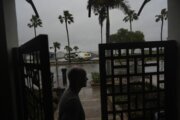In medical research centers around the country working to fight cancer, birth defects and infectious disease like HIV/AIDS, dismay is in the air around executive orders on travel bans. International medical, research and patient organizations are pushing back with concerns about the chilling effects of losing the talents of foreign-born scientists in U.S. labs. And within these labs, budding scientists who come here to learn and contribute must take time out to worry about visa documents and airport interviews.
The contribution of scientists from other countries is on everyone’s radar right now, says Dr. Ben Park, an oncology professor at the Johns Hopkins Kimmel Cancer Center in Baltimore. “To put travel bans and limitations on visas to work here — for the biomedical community, it’s really akin to taking a leg off,” he says. “And that’s probably not hyperbole.”
The notion that only those from the six currently targeted countries need worry isn’t the reality, says Park, who heads up the center’s hematology-oncology fellowship training program as well as the program for research training and education. “Many people who are international trainees and students are fearful,” he says. And for researchers who are putting up to 60 painstaking hours in the lab some weeks, or working until midnight to see experiments through, distractions like these don’t help.
Nearly 70,000 immigrants are estimated to be working in medical, life and other science occupations across the country, according to the Institute for Immigration Research. Immigrants comprise 40 percent of U.S. medical scientists in manufacturing research and development, and 50 percent of those in strong biotechnology states.
Of researchers at the top seven U.S. cancer research centers in 2013, 42 percent were foreign-born, according to the latest-available figures from the National Foundation for American Policy. And in a 2016 policy brief, the NFAP found immigrants were awarded 40 percent of the Nobel Prizes won by Americans in chemistry, medicine and physics since 2000. Last year, all six American winners in economic and scientific fields were immigrants, according to the NFAP.
In Park’s office down the hall from his lab, where he serves as both leader and mentor of his internationally diverse team, he has just obtained figures from the Johns Hopkins School of Medicine on its nonclinical postdoctoral fellows — those who focus on research. “Almost 70 percent are international trainees,” he says. “I didn’t even know it was that high.”
Dedicated Scientists
Inside Park’s breast cancer research lab at Hopkins, some 15 scientists and trainees work side by side at their benches, among pipettes, test tubes, petri dishes, beakers, water baths, computers, refrigerators for storing samples and an RNA-extraction system to isolate genetic material from cells.
[See: 8 Cool Uses for 3-D Printers in Health Care.]
One of them, Karen Cravero, a doctoral candidate and newly naturalized U.S. citizen, pulls off her purple synthetic-rubber gloves. Cravero is using gene-editing techniques to study what’s called the NOTCH1 gene, which is associated with several types of cancer, including aggressive and hard-to-treat triple-negative breast cancer.
Cravero has loved science since childhood. “When I was younger, I watched CSI with my mom,” she recalls. “One time they got a cheek swab and they were able to find the killer and I was like, ‘Wow, science is cool.'”
At 11, Cravero moved to the U.S. from Peru, where she had lived through the nation’s 1991 cholera epidemic. “I remember walking around and seeing people that I knew unfortunately dying on the streets,” she recalls. “My mom would say, ‘Don’t talk to anybody; don’t touch anybody. Just go into the house.’ The commercials were all about making sure not to drink any unboiled water. Because cholera is a waterborne pathogen.”
As a college undergraduate in Pensacola, Florida, Cravero says, “I did a lot of microbiology, which included collecting sewage in the mornings, which was not pretty,” she says. “We wanted to test contamination in the water, because that’s the water people swim in and drink.” They analyzed the water for cholera, among other organisms, which, thankfully, they didn’t find.
After graduating, Cravero moved on. Johns Hopkins offered her an opportunity to rotate through different laboratories and participate in studies on conditions such as cystic fibrosis and HIV/AIDS. For Cravero, who has a strong family history of cancer, joining Park’s research team was particularly meaningful.
Last November, Cravero attained her U.S. citizenship after at least 10 years here as a permanent resident. She’s happy and relieved to be a citizen, she says, along with her two small sons who were born in the U.S. Only she hopes it’s not a false sense of security in these uncertain times.
Diversity benefits science, especially medical science, Cravero says, where cures can be elusive. “When it comes to a complex scientific problem, the more points of view you have, the higher likelihood of actually coming up with a solution.”
[See: What Not to Say to a Breast Cancer Patient.]
Barrier to Breakthroughs
In biomedical research labs across the country, a significant portion of postdoctoral fellows are noncitizens who come here to work on research projects through professional visas, says Dr. Carlos Arteaga, the associate director for clinical research and co-leader of the breast cancer research program at Vanderbilt-Ingram Cancer Center in Nashville, Tennessee.
While the impact would vary across institutions, if people weren’t allowed to travel freely, a considerable proportion of the workforce would be lost, says Arteaga, who is a past president of the American Association for Cancer Research. Among the missing, he says, would be “a number of people doing the hands-on bench work. Pursuing discoveries and thinking of breakthroughs. These are people doing real work and making real contributions.”
Applying for a job in a top-flight U.S. research university is not a simple undertaking. “There’s a natural selection that goes on,” Arteaga says. “You need someone who’s ambitious and is willing to leave his or her country to come here for professional, educational and training reasons.”
Vetting takes place at the facility to which the person is applying, Arteaga points out. “If the applicant is not that great, he or she doesn’t receive an [offer],” he says. “There is a rigorous selection [process].”
Translating Science to Patient Care
Swathi Karthikeyan, 26, a doctoral candidate at Hopkins who is eager to translate scientific findings to breast cancer treatments, works at her bench. She’s creating models to determine how mutations in separate cells come together to form a malignant tumor.
During her junior year at college in India, Karthikeyan had a personal breast-cancer scare. Fortunately, what she and her family feared was a malignant growth turned out to be benign. But she still remembers her own emotional upheaval and the plight of patients with cancer whom she encountered during clinic checkups.
[See: 9 Things You Didn’t Know About Sickle Cell Disease.]
An internship with a biotech firm in India helped Karthikeyan realize that a lab environment was where she belonged. But U.S.-based facilities provided the best opportunities for the research she most wanted to do. Her U.S. journey has included a stint in a lab doing liver cancer research, and now she’s on the Johns Hopkins breast-cancer team.
“This disease is probably the worst battle mankind is ever fighting,” Karthikeyan says. “There are so many research lines which are flourishing in this field. But there is nothing concrete. It still needs more scientists. It still needs more people.”
Early this year, Karthikeyan renewed her F-1 student visa, an intense process that required her to fly back to the American embassy in India with supporting documents crammed into her carry-on bag. She’s glad to be back. “When I came here it was such a pleasant surprise,” she says. “I genuinely feel that Americans are very accepting as people.”
Once their visas expire, scientists may return to their home countries to share their knowledge. Others stay, however, renewing their visas and eventually, in some cases, applying for U.S. citizenship. For some people, Park says, that’s been the pathway to illustrious careers in elite U.S. facilities, contributing to the betterment of science and human health for not only Americans, but people around the world.
More from U.S. News
Which Medical Screenings Should You Have in 2017?
7 Things You Didn’t Know About Lung Cancer
7 Innovations in Cancer Therapy
Empty Labs: What Medical Research Without Immigrants Looks Like originally appeared on usnews.com







